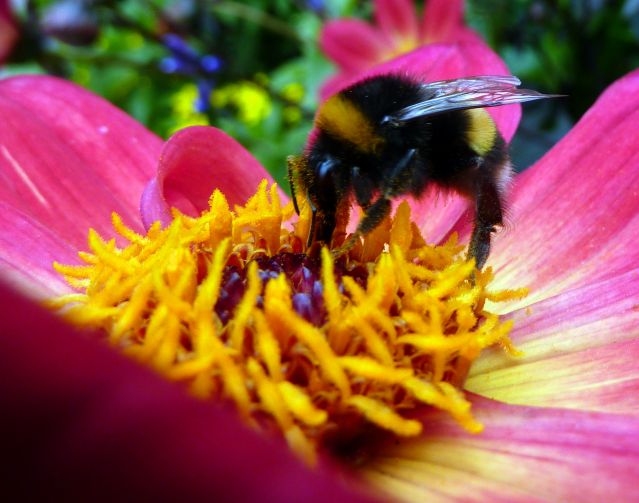Memory
Foraging Through Our Memories
The evolutionary basis for remembering and forgetting
Posted March 16, 2015
Your significant other is sending you to the grocery store. You rehearse the list in your head a couple of times, and then, confident you’ll remember, you head off for the market.
You walk into the store, and the first three items come to mind—milk, butter, and yogurt. So it’s off to the dairy section. With these in your basket, you recall the next set of items—spaghetti, sauce, and ground beef—which you’ll need for dinner. Then you remember you also need to get lettuce, tomato, and a cucumber for the salad.
There were ten items on the list, but you’ve only got nine in your basket. You think as hard as you can, but you just can’t remember that last item. Forlorn, you go through the checkout and head home, knowing you’ll be in the doghouse for not writing a shopping list.

A honeybee is working a field of clover. She samples several flowers in one cluster before moving on to the next. She checks out several of these flowers and then buzzes over to another cluster.
The honeybee doesn’t exhaust all of the flowers in one cluster before moving on, and she doesn’t skip randomly from cluster to cluster, either. Instead, she follows an adaptive foraging strategy that’s been honed over hundreds of millions of years of evolution and is widely practiced across the animal kingdom.
Birds follow this optimal foraging strategy as well. They don’t pluck all the berries off a bush before moving to the next. Rather, they pick the easy berries, and then they try another bush nearby. This strategy is considered optimal because it produces the greatest yield in a set amount of time, compared with either scouring a particular resource or sampling randomly from multiple resources.

Searching for grocery items in memory is a lot like foraging for food in the wild. In nature, food resources tend to be clustered, with the clusters spaced some distance apart. In our language-based semantic memory, ideas are also clustered.
When people are asked to recall items from a list, they tend to name those words in meaningful clusters—even when they weren’t originally presented that way. You’d memorized your shopping list in random order. But when you got to the store, the first item you recalled was milk. This triggered the dairy cluster, with butter and yogurt coming rapidly to mind.From there you browsed the pasta and salad clusters of semantic memory, plucking the items you needed for dinner. But that tenth item eluded you, perhaps because it didn’t cluster with any of the other items.
The analogy between foraging for food and searching semantic memory isn’t just philosophical.1 Indeed, the same brain systems and chemical processes are involved in both. This suggests that a general cognitive mechanism underlies both internal memory searches and external forages for resources. What’s more, we share this general cognitive mechanism with many animal species.
A trait that originally served one purpose can later come to serve an entirely different purpose. The lungs of terrestrial vertebrates evolved out of the gas bladders that fish use for buoyancy. This is true of cognitive processes as well. For instance, the brain system for processing physical pain also processes the pain of social exclusion. (Despite the old saying, names do hurt just as much as sticks and stones!)
Evolution is conservative, meaning that it can’t make new structures or functions out of nothing just because they’re useful. Rather, it jury-rigs new traits from what’s already there. Imaginary vertebrates such as griffins and angels, with wings on their backs, aren’t just non-existent—they’re impossible. Certainly vertebrates can fly—both bats and birds manage it. But they’ve done so by reshaping their forelimbs into wings, not by growing a pair on their backs.

Despite the apparent uniqueness of the human mind, it would be surprising to find any sort of cognitive process in humans that simply couldn’t be traced back to our evolutionary ancestors. The notion that human language—or any of its functions—arose suddenly and fairly recently in our past is just as improbable as angels’ wings.
Notes
1For a different perspective, see Abbott, Austerweil, & Griffiths (2015).
References
Abbott, J. T., Austerweil, J. L., & Griffiths, T. L. (2015). Random walks on semantic networks can resemble optimal foraging. Psychological Review. Advance online publication. http://dx.doi.org/10.1037/a0038693.
Hills, T. T., Jones, M. N., & Todd, P. M. (2012). Optimal foraging in semantic memory. Psychological Review, 119, 431-440.
Dougherty, M. R., Harbison, J. I., & Davelaar, E. J. (2014). Optional stopping and termination of memory retrieval. Current Directions in Psychological Science, 23, 332-337.
David Ludden is the author of The Psychology of Language: An Integrated Approach (SAGE Publications).




